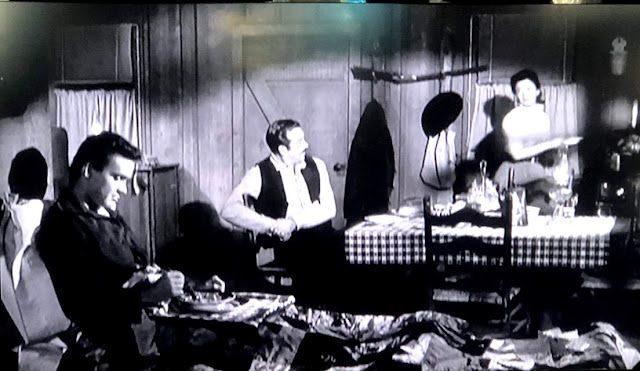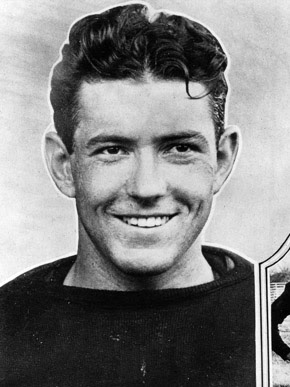Released in 1959, Odds Against Tomorrow is often cited as one of the last entries of
film noir's classic period that began in the late 1930's. Harry Belafonte, Ed Begley,
Jr. and Robert Ryan star in this dark and gritty piece about a small town bank
robbery. Shelley Winters and Gloria Grahame are also in the cast.
In addition to that great cast and a tight story, the film has a couple of other pluses.
There's a side conflict between Ryan's racist character and Belafonte that adds
even more tension as the plot unfolds. Odds also has a wonderful musical score
written by pianist John Lewis of the Modern Jazz Quartet. In addition to band mates
Percy Heath [bass], Milt Jackson [vibraphone], and Connie Kay [drums], the
orchestration includes the fabulous Bill Evans on piano and Jim Hall on guitar.
Jr. and Robert Ryan star in this dark and gritty piece about a small town bank
robbery. Shelley Winters and Gloria Grahame are also in the cast.
In addition to that great cast and a tight story, the film has a couple of other pluses.
There's a side conflict between Ryan's racist character and Belafonte that adds
even more tension as the plot unfolds. Odds also has a wonderful musical score
written by pianist John Lewis of the Modern Jazz Quartet. In addition to band mates
Percy Heath [bass], Milt Jackson [vibraphone], and Connie Kay [drums], the
orchestration includes the fabulous Bill Evans on piano and Jim Hall on guitar.
The MJQ released a soundtrack album the same year.
This film has a possible Alabama connection and another certain one. The novel
that started it all by William P. McGovern was first published in 1957. I've
explored McGivern's supposed Mobile connections in a blog post.
The other Alabama connection appears about midway through the movie. Robert
Ryan goes into a bar for a drink, and a soldier and his girl are horsing around. Ryan
takes offense and the final result is a fight in which the soldier ends up on the floor.
The soldier is played by none other than Wayne Rogers.
He was born in Birmingham on April 7, 1933. After graduating from Princeton and a
stint in the Navy, Rogers began appearing in small roles in Hollywood. His debut was
auspicious, although credited only as a main character's "tennis opponent" in the
Alfred Hitchcock classic 1951 Strangers on a Train. His IMDB credits show a gap until
1959, when he made appearances on the TV soap opera Search for Tomorrow and
as that guy in the bar in Odds. In the 1960's he had numerous roles in TV shows
ranging from Have Gun Will Travel to Gunsmoke and Honey West. He even appeared
with fellow Alabama native Jim Nabors on Gomer Pyle USMC.
Of course, Rogers went on to great fame in the popular M*A*S*H TV show where
he was a regular for three seasons 1972-1975. He continued acting in
films and TV movies and shows until 2003. In one of those roles he played Alabama
native and attorney Morris Dees in the 1996 film Ghosts of Mississippi.
Rogers died on New Year's Eve 2015.
This film has a possible Alabama connection and another certain one. The novel
that started it all by William P. McGovern was first published in 1957. I've
explored McGivern's supposed Mobile connections in a blog post.
The other Alabama connection appears about midway through the movie. Robert
Ryan goes into a bar for a drink, and a soldier and his girl are horsing around. Ryan
takes offense and the final result is a fight in which the soldier ends up on the floor.
The soldier is played by none other than Wayne Rogers.
He was born in Birmingham on April 7, 1933. After graduating from Princeton and a
stint in the Navy, Rogers began appearing in small roles in Hollywood. His debut was
auspicious, although credited only as a main character's "tennis opponent" in the
Alfred Hitchcock classic 1951 Strangers on a Train. His IMDB credits show a gap until
1959, when he made appearances on the TV soap opera Search for Tomorrow and
as that guy in the bar in Odds. In the 1960's he had numerous roles in TV shows
ranging from Have Gun Will Travel to Gunsmoke and Honey West. He even appeared
with fellow Alabama native Jim Nabors on Gomer Pyle USMC.
Of course, Rogers went on to great fame in the popular M*A*S*H TV show where
he was a regular for three seasons 1972-1975. He continued acting in
films and TV movies and shows until 2003. In one of those roles he played Alabama
native and attorney Morris Dees in the 1996 film Ghosts of Mississippi.
Rogers died on New Year's Eve 2015.
Here are the three leads: Harry Belafonte, Ed Begley, Sr., and Robert Ryan
































































